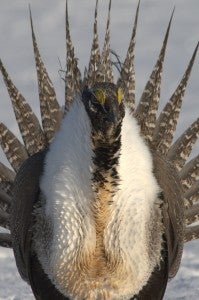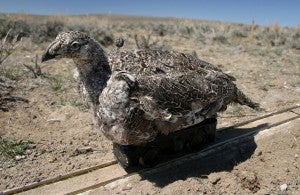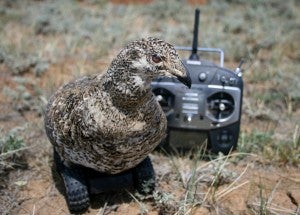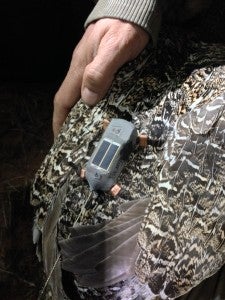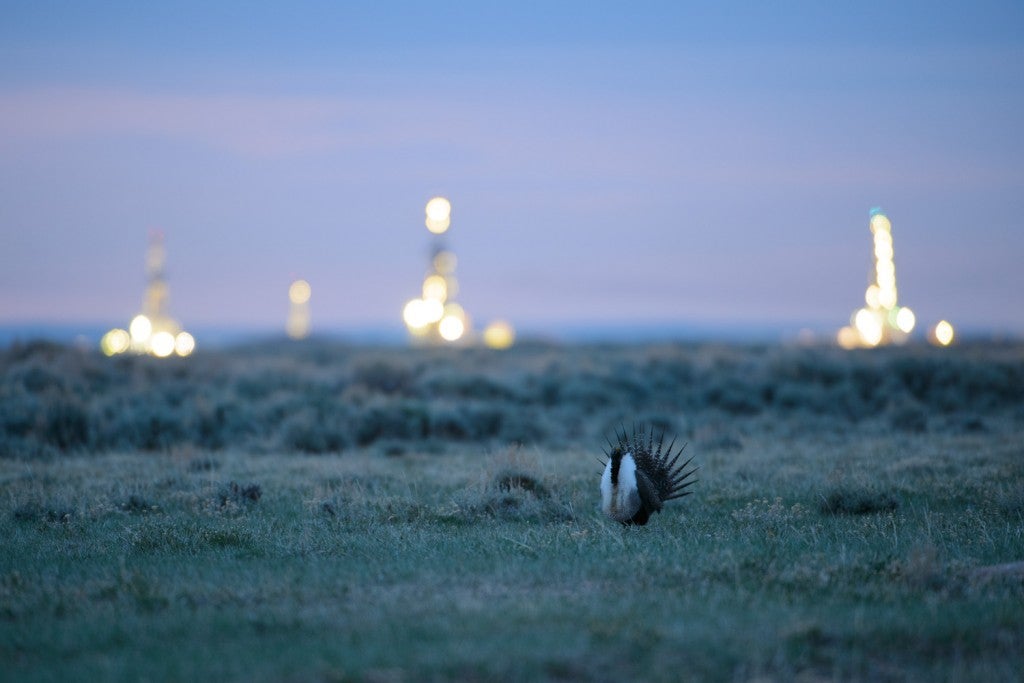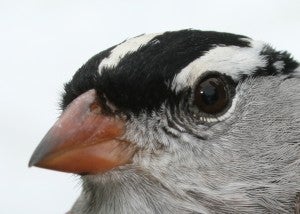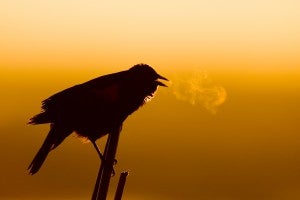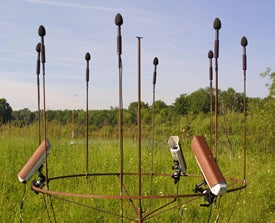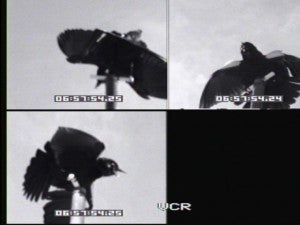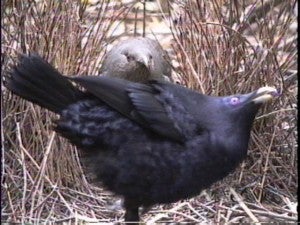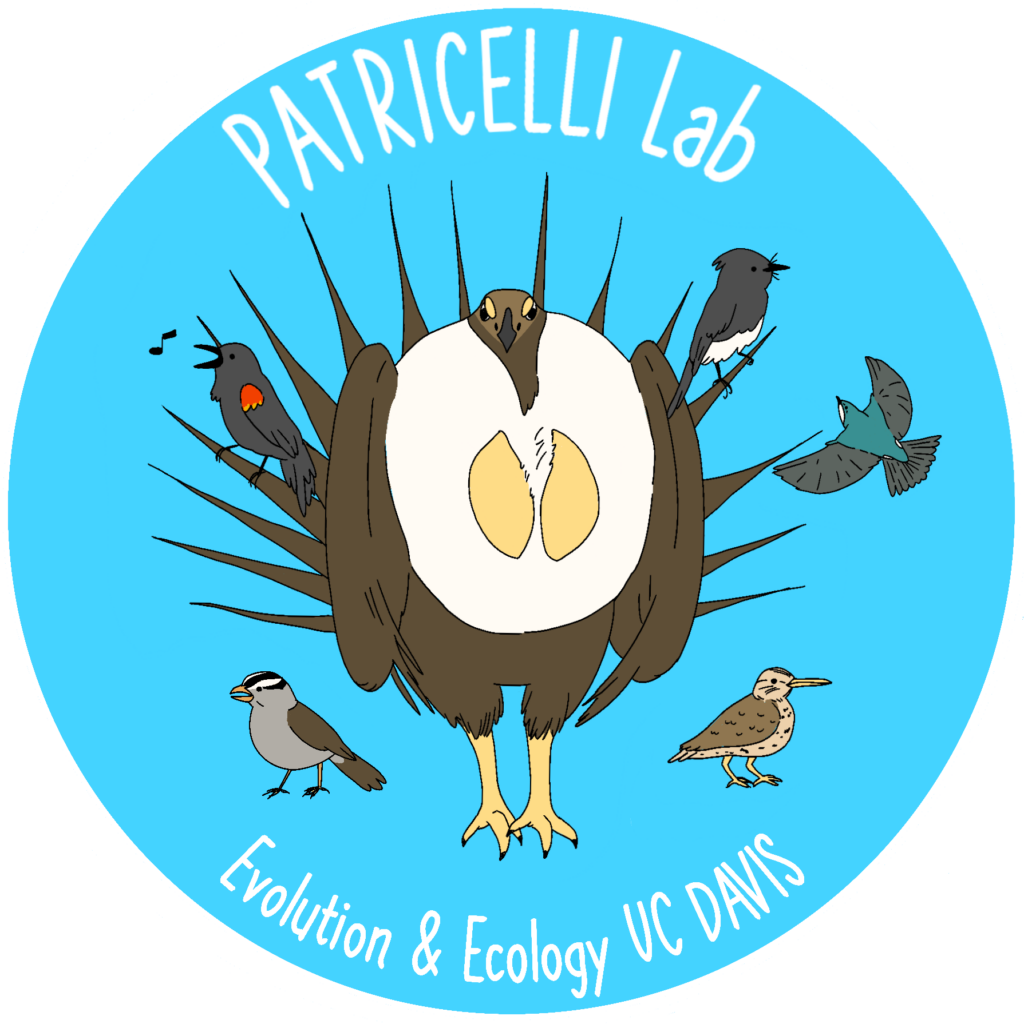The signals used by animals to communicate are among the most beautiful features of the natural world, including a dizzying array of sounds, smells, colors, dances, electrical fields and seismic vibrations. Research in the Patricelli Lab addresses the function of these signals and why they take on such diverse and complex forms. Our approach has been integrative, examining functional, environmental and mechanistic influences on signal form and signaling behaviors. To accomplish this, we have pioneered new techniques and technologies for the detailed observation and experimental manipulation of both visual and acoustic signals in the field, including biomimetic robots and microphone arrays.
One of the central goals of research in the Patricelli Lab is to understand how animal signals and other breeding behaviors are influenced by the environmental contexts in which they are used. For many bird species, the environment is now shaped largely by humans. Therefore, another major goal of research in the Patricelli Lab is to understand the impacts of human activities, especially urbanization and noise pollution, on bird communication, breeding ecology, and reproductive success. The Patricelli Lab has played an active role in translating our research results into recommendations for more effective management of habitat for sensitive species, and in promoting the importance of basic research and conservation to the public through public lectures, outreach events, and engagement with the media.
Below is a description of some of the major projects in the lab:
- Sexual Selection in Sage-Grouse
- Impacts of Noise Pollution on Birds
- Urban Ecology of Songbirds (Project Phoebe!)
- Directional Communication in Songbirds
- Past research Sexual Signaling in Bowerbirds
In addition to these projects, there are many exciting projects developed by graduate students and postdocs in the Patricelli Lab, which are described on the Graduate Student and Postdocs pages. There is also a link to Media Coverage of our Research.
Sexual Selection in Sage-Grouse
Males in many species must convince females to mate by producing elaborate courtship displays that are attractive to choosy females. This requires the ability to produce signals tuned to the female’s sensory system, like the buzzing of a cicada or the tail of a peacock. It may also require courtship tactics, such as the ability to choose a display site that flatters the male’s signals, or respond appropriately to female courtship signals (Patricelli et al. 2011). Much of the research on sexual selection focuses on signals, rather than the tactics with which they are deployed. But this approach may reveal only part of the picture. For example, in my dissertation research on satin bowerbirds (described below) I found that courtship tactics—the ability of males to adjust their signals in response to female behaviors—are equal in importance to the quality of the male’s signals in explaining which males are preferred by females (Patricelli et al. 2002, 2006). Learning how male signals and tactics combine to stimulate the female is therefore central to answering one of the major questions in evolutionary biology—how sexual selection has favored the astonishing diversity and complexity of animal signals.
In 2005, postdoctoral researcher Dr. Alan Krakauer and I began research using greater sage-grouse as a model system to understand how male signals and courtship tactics influence female mate-choice decisions. Sage-grouse are an ideal system for studies of sexual selection, because we know a great deal about their breeding biology. Male sage-grouse gather in the spring on strutting grounds called leks (see a video here) to court visiting females with fantastic visual and acoustic displays called struts (see a video here, or an even cooler high-speed video here). To experimentally manipulate and measure these complex strutting signals and courtship interactions between males and females, we developed robotic female sage-grouse with the help of many wonderful engineers (Tom Fowler, Jonathan Tran, Scott McKibben and Jose Mojica). These fembots provide an experimental stimulus to study interactions between males and females (Patricelli 2010). The robots are also equipped with onboard video and audio recorders, allowing us to literally get inside the head of a female on the lek, observing courtship from her perspective.
In spring 2007, Alan Krakauer and I used the first version of the fembot, which traveled the lek on G-scale model train tracks (see a video here), to examine tradeoffs in male sage-grouse courtship between display quantity (strut rate) and quality (a temporal feature of the strut vocalization associated with success in mating). Previous research by Robert Gibson found that females prefer males that display at high quantity and quality (Gibson 1996), but found a tendency for males to be good at one or the other, suggesting a possible tradeoff. We used controlled approaches of the fembot to experimentally induce changes in male display rate. We found that males who are more successful in mating can increase quality and quantity simultaneously, with only unsuccessful males facing a tradeoff. Successful males appear to avoid a tradeoff by adjusting their display rate—saving energy by displaying at low levels when females are farther away and higher levels as females approach. To be successful, males may therefore need both the ability to produce attractive signals, and the ability to tactically allocate their limited display energy by responding to female behaviors (Patricelli and Krakauer 2010).
We also used this fembot to elicit male display behaviors for a study of ‘swishes’, feather-produced mechanical sounds (which can be seen at the beginning of each strut in this video or this high-speed video), with UCD undergraduate honors student Rebecca Koch (Koch et al. 2015), as well a study of the laterality of courtship and aggressive behaviors (Krakauer et al. submitted; see video of a fight here, or a super awesome high-speed video here). Click here to see video clips featuring the robot by the Sacramento Bee, Science Nation and PBS Nature.
The second generation robots are built on a tank body with four independently controlled wheels, allowing more versatile and realistic movements (my taxidermy skills have thankfully improved as well). The new robots are also designed to mimic female behaviors indicating interest or lack of interest in mating (see a video here). We have been using these fancy new robots to examine courtship negotiations on the lek, using economic analogies of an open marketplace to guide our research questions (Patricelli et al. 2011). Graduate student Anna Perry used these robots in experiments examining male response to female signals during courtship and how males change their behavior when females switch from interested to uninterested or vice versa (Perry et al. 2019). Graduate student Ryane Logsdon used the fembots more recently to examine whether males alter their display behavior toward an uninterested female when an outside option (another female) is available. Ryane is also examining how how habitat structure–whether leks are open or covered in sagebrush–affects the flow of information through the social network of the lek; this work is being done in collaboration with Professor Jennifer Forbey at her lab at Boise State University.
Graduate student Eric Tymstra, in collaboration with Jennifer Forbey and graduate students from Boise State University as well as Peter Coates from the USGS, are expanding our use of economic models of negotiation to understand on- and off-lek dynamics in sage-grouse. To do so, we have been radio-tracking birds at Wyoming and California sites using Encounternet radio-tags and GeoTrak satellite tags. These tags allow us to determine when and where sage-grouse forage off lek. In Dr. Forbey’s lab, we will analyze the nutritional content of sagebrush that is eaten or ignored by sage-grouse (protein, fat and toxin levels). This project is allowing us to understand how males acquire energy during the breeding season and it produce breeding displays. This will link optimal foraging and sexual selection, with a focus on understanding how tactics in both arenas are related. One of the biggest conservation threats that sage grouse face is habitat loss to wildfire. Graduate student Maria Ospina is therefore expanding this project to look at how different methods for post-fire restoration affects foraging behaviors, diet quality, courtship and reproductive success in a Nevada population of sage-grouse.
For our studies of the sage-grouse, we have also collaborated with John Burt to expand the ADM system into a 24-microphone array. This array can record male signals and localize to within a meter of the sound source by measuring the time delays of the sound reaching multiple microphones. In addition to measuring directionality, our array can be used to locate the males on the lek. Each time a male vocalizes, we can measure the time delay of the sound reaching each of the microphones and use this data to triangulate the male’s position to within 0.5 meters. Using these location data, we can create detailed maps of male territories, and examine male vocal interactions along territory boundaries. We can also accurately pinpoint the male’s location relative to the robotic female (Patricelli and Krakauer 2010). This is an exciting technology with great promise for studies of animal ecology, as it allows non-invasive monitoring of animal movements (Blumstein et al. 2011).
The microphone array played a critical role in our discovery that male sage-grouse often produce two simultaneous and independent sounds—a “double whistle”—despite being Galliformes, which were thought to have only a single sound source in their syrinx. The detection of these double whistles on audio recordings led to a collaboration with Dr. Franz Goller from The University of Utah, where we found anatomical evidence for two-voiced sound production in greater sage-grouse (Krakauer et al. 2009).
Why Basic Research?
Our research on sage-grouse behavior is made possible by grants from the National Science Foundation and funding from UC Davis. Much of our research uses sage-grouse as a model system to address long-standing questions about how animals evolve and interact with each other and with their ecosystems. In addition to increasing our understanding of the world in which we live, such basic research also has tangible applications and benefits to society. Conservation is one important area where basic science contributes. As sage-grouse populations have declined, basic research on sage-grouse breeding, foraging, and habitat-usage behaviors has contributed in innumerable ways to conservation efforts. Our research on the importance of sound in mate choice on the lek informs every aspect of our applied research, described below, addressing the impacts of noise pollution on breeding behaviors. Basic research points us toward the right questions to ask, informs our methodological approaches, and provides data for our studies. For an excellent discussion of the importance of basic research, please read some of the recent articles (here and here) by the awesome Patricia Brennan.
Impacts of Noise Pollution on Birds
To communicate successfully, signals must be detected by receivers; this selects for signals that contrast with the background in the habitats where they are used. Background noise is therefore an important selective factor on acoustic signals, since noise can mask signals, making detection impossible. Across much of the world, the background noise is now largely human produced, yet we are only now learning how this noise pollution affects wildlife. This issue has clear conservation implications, but also provides a “natural” experiment allowing us to examine how noise acts as a selective agent on animal signals.
SAGE-GROUSE:
Species that rely on acoustic communication to find and court mates may be particularly vulnerable to noise pollution, and one such species is the greater sage-grouse. Populations of sage-grouse are declining throughout their range, leading to their consideration for listing under the U.S. Endangered Species Act (learn more about the sagebrush sea here). Previous studies showed that natural gas development was associated with rapid declines in local populations (e.g. Holloran 2005, Naugle et al. 2011). In 2005, my lab began a project to investigate whether noise from natural gas development may contribute to these declines by interfering with sage-grouse breeding activity.
Our first major objective is to characterize noise from energy development and the acoustics of mate choice in sage-grouse, then develop tools which use this information to predict the impacts of noise pollution. Toward this end, we have collected more than 700 measurements of noise levels in energy development areas across Wyoming. Working with postdocs Dr. Stacie Hooper and Dr. Sean Hanser and collaborating with the National Parks Service Natural Sounds and Night Skies Division, we used these measures to adapt existing software (NMSim) to model noise propagation across the sagebrush landscape. We are using these data to build noise layers for spatially-explicit habitat-selection models using this program. This will allow us to test whether changing noise levels in a Wyoming natural-gas field between 1998 and 2011 explain observed declines in lek attendance and nesting success over that period. Thus we will estimate the relative importance of noise compared to other types of habitat disturbance, and more importantly, estimate the threshold exposure level at which noise affects sage-grouse populations.
Our second major objective is to examine whether energy-development noise alone impacts sage-grouse, controlling for other disturbances associated with development. To do so, Dr. Jessica Blickley and former postdoc Dr. Diane Blackwood conducted a long-term experiment, introducing noise from natural gas development (from roads and drilling) on treatment leks and control leks over three consecutive breeding seasons. At the population level, we found a dramatic decline in male attendance on experimental-noise leks, and a trend toward lower female attendance (Blickley et al. 2012a). We also found that fecal stress-hormones (glucocorticoids) were elevated on noise leks compared to controls, suggesting that noise has a physiological impact on sage-grouse (Blickley et al. 2012b). Using recordings from our microphone array, we also examined the potential of noise from energy development to mask the sounds produced by lekking sage-grouse (Blickley and Patricelli 2012). We have translated our results into recommendations (e.g. Blickley and Patricelli 2010, Patricelli et al. 2013) and worked directly with policy makers to implement them as management strategies.
In addition to examining noise impacts on sage-grouse, the Patricelli Lab has many past and ongoing studies addressing noise impacts on songbirds.
We collaborated with Dr. Ondi Crino and Professor Creagh Breuner from the University of Montana to study the impacts of highway noise on the stress-response in nestling white-crowned sparrows (Crino et al. 2013). We did this work in Tioga Meadows, a long-term field site near the east entrance to Yosemite National Park. Current graduate student Carly Hawkins is also working on white-crowned sparrows at this site to examine how how noise impacts mate fidelity and sperm competition.
In addition, former UC MEXUS postdoctoral fellow Dr. Alejandro Ríos-Chelén investigated noise impacts on communication in red-winged blackbirds. Redwings produce visual display in combination with their songs; we hypothesized that in high noise areas where acoustic communication is less effective, males might compensate by increasing the intensity of their visual displays. We collected audio and video recordings and noise levels at high- and low-noise areas. We found that males in high noise area sing shorter songs with slower trills. These males also show less variability in their visual signaling, which suggests that rather than compensating for acoustic masking with visual displays, visual communication may be hampered by noise (Rios-Chelen, et al. 2015).
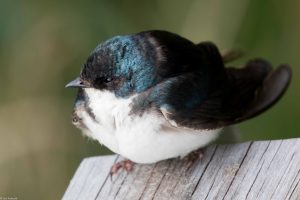
Tree Swallow looking grumpy. © Gail Patricelli
Research by former graduate student Allison Injaian examined the impact of noise pollution on parental behavior and nestling development in tree swallows (Tachycineta bicolor) near Davis. With the help of UC Davis Honors student Lauren Poon, Alli found that tree swallows avoided settling in nestboxes with experimental playback of highway noise (Injaian, et al. 2018). She also found that noise negatively impacted nestling growth, affected stress-associated hormones, and increased processes associated with aging (oxidative stress and telomere attrition; Injaian et al. 2018, 2018 and 2019). This work was done in collaboration with former Patricelli Lab member Conor Taff, Maren Vitousek from Cornell University, Mark Haussmann at Bucknell University and John Wingfield from UC Davis. Current graduate student Alicia Bird has been investigating how noise playback affects pairing by aggressiveness, an aspect of personality, and whether it leads to changes in markers that affect gene expression (methylation).
Urban Ecology of Songbirds (Project Phoebe!)
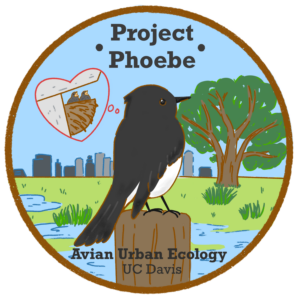
Project Phoebe Logo © Ian Haliburton
Project Phoebe is an urban ecology research project designed and run by three Ph.D. students at the University of California Davis, Sage Madden, Jacob Johnson, and Ian Haliburton, with the help of a fantastic group of undergraduate researchers. Visit The Project Phoebe Team page to learn more about our team members. The project is supervised by Professors Gail Patricelli and Thomas Hahn. We are studying Black Phoebes in the California Central Valley to learn more about how birds and other animals respond to urbanization and other forms of environmental change.
Want to learn more about Project Phoebe? You can find more details about our project goals on the What we Hope to Learn page and the Where we Work page.
Directional Communication in Songbirds
Studies of animal communication have addressed how acoustic signals are adapted to their social function, their ecological context and the physiology of the communicating animals. An important aspect of acoustic communication has been largely left out of these studies—the directionality of acoustic radiation—because measuring directionality has proved extremely difficult. Sound waves radiate in all directions from a vocalizing animal, and directionality occurs when sounds are not equally loud in every direction. Omnidirectional vocalizations will maximize the number of surrounding neighbors that hear the vocalization, whereas more directional vocalizations will allow individuals to beam the sound to a receiver and decrease eavesdropping by competitors or predators. Despite its importance, we know little about how directionality varies with signal function, sender morphology and behavior, and the environment in which the signal is used.
To address this gap in our understanding of animal communication, I initiated a project as an NSF postdoctoral fellow in bioinformatics at the Cornell Laboratory of Ornithology in collaboration with Marc Dantzker and Jack Bradbury, to develop an acoustic directionality measurement (ADM) system. The system we developed combines digital audio and video recording with algorithms for data analysis and visualization. The ADM system measures amplitude simultaneously on 8 microphones arrayed around vocalizing animals in the field, allowing us to reconstruct acoustic radiation patterns in the horizontal plane.
Our first study using the ADM system focused on red-winged blackbirds (Agelaius phoeniceus) as a model system. We found that directionality differs significantly among types of vocalization (songs, alarm calls, alert calls and copulation-solicitation calls) and that the call types with the highest potential cost of eavesdropping are the most directional (Patricelli et al. 2007). In addition, we found that males adjust both signal structure and singing behavior to match the radiation of their songs to their social function: males rotate less on their perches while signing directional songs, beaming signals to intended receivers in direct interactions, and rotate more while singing more omnidirectional songs, maximizing radiation of advertisement signals (Patricelli et al. 2008). Click here to see an animated plot of the radiation of a song in red-winged blackbirds.
More recently, NSF Postdoctoral Fellow Dustin Reichard, in collaboration with Preston Wilson‘s lab at the University of Texas, Austin, used the ADM to collect detailed measures of directionality on male redwinged blackbirds in an anechoic chamber. This study will address whether backpack mounted radio-transmitters can be calibrated to measure amplitude from free-living birds. You can read more about Dustin’s research here.
As a graduate student in the Patricelli Lab, Dr. Jessica Yorzinski used the ADM to record and analyze the directionality of antipredator calls in songbirds. It is often unclear whether communication with predators or conspecifics (or both) has favored the evolution of antipredator calls, as both receivers may detect them. By determining the directionality of mobbing calls and how they are “aimed” with respect to possible receivers, we can make inferences about the target of these calls. In this study, we found that birds in most species emit directional calls when they face the predator and broadcast more omnidirectional ones when they face away from the predator. Surprisingly, birds in some species appear to “talk out of the sides of their mouths”—directing their mobbing calls to toward the predator even when facing to the side. These results suggest that birds use antipredator calls to communicate with both predators and conspecifics, and that they do so with unexpected sophistication and plasticity (Yorzinski and Patricelli, 2010).
Sexual signaling in bowerbirds
Dr. Patricelli’s dissertation research addressed sexual selection and the interaction between males and females during courtship in satin bowerbirds (Ptilonorhynchus violaceus). This work was conducted at the University of Maryland, College Park in collaboration with her dissertation advisor, Gerald Borgia, and colleagues Albert Uy and Seth Coleman.
During courtship, male satin bowerbirds must give intense and aggressive courtship displays to be attractive, but these same displays may threaten females, startling them and disrupting courtship (see a video here). In an analysis of natural courtships, we found that a female behavior (“crouching”) signals the degree of intensity that females will tolerate without being startled—and that females tolerate increasingly intense displays as mate-searching progresses (Patricelli et. al. 2004). Thus by giving higher intensity displays as female crouching increases, males can display intensely enough to be attractive without threatening the female with displays more intense than she is ready to tolerate.
We tested the hypothesis that male satin bowerbirds reduce the threat of their courtship displays by modulating their display intensity in response to female crouching. To do this, we developed robotic female bowerbirds (see picture above, and click here for video), which allowed us to experimentally control crouching and measure male response in the field. We found that males respond to increased female crouching by increasing their display intensity, such that the highest-intensity displays are given when females are less easily threatened. Further, we found that males more effective at modulation startle females less often in natural courtships, improving their courtship success. These results suggest that despite female preference for intensely displaying males, successful males do not always display at maximum intensity, rather, they modulate their intensity in response to female signals. Thus in satin bowerbirds—and in other species where male-female interactions have not yet been examined in detail—sexual selection may favor males with the intrinsic ability to produce attractive displays and the ability to modify them in response to female signals (Patricelli et al. 2002 and 2006).
Dr. Patricelli’s dissertation research also addressed the role of multiple male displays in female choice. Males of many species have multiple sexual display traits; there has been a great deal of interest in how multiple male traits evolve, and how they are maintained by sexual selection. To understand the evolution of multiple traits, it is critical to understand how each trait influences female choice. We addressed this issue by examining signals and cues given by the female to determine which male display traits are assessed by females during mate choice, and when. We found that females tolerate higher intensity courtship displays from attractive males than from unattractive males—they crouch more for attractive males and startle less during early courtships. This effect appears to be caused by physical display traits (bower decorations), which reduce the likelihood that females will be startled. This suggest that male bower decorations may facilitate the expression of more intense—and thus more attractive—male behavioral displays during courtship and that multiple physical and behavioral traits may interact to influence female choice (Patricelli et al. 2003).
Media coverage of research:
DailyDemocrat story about Project Phoebe: ‘Project Phoebe’ Looks at City and Rural Birds
Big Biology podcast interview of Dr. Patricelli, Beauty of the Beasts
Radiolab episode on the evolution of beauty, The Beauty Puzzle
WIRED magazine story and video about the sage grouse robot
Science Nation video on our sage-grouse studies for the National Science Foundation
PBS NATURE Special “What Females Want and Males Will Do” featuring the sage-grouse research
Interview about bowerbirds and sage-grouse for The Science Show on ABC Radio (Australian public radio)(download podcast here)
Live studio interview about the sage-grouse research on Insight, a Capitol Public Radio (90.9) program (download the Podcast here)
Sacramento Bee video of the sage-grouse fembot and accompanying story about our research
Discover Magazine article on Robots used for conservation
Nature magazine article about robots in research
CNN: http://archives.cnn.com (note that I look suspiciously like a fembot in the photo they used …)
National Geographic: http://news.nationalgeographic.com
Quirks & Quarks radio show: http://www.radio.cbc.ca/programs/quirks
Science News magazine: http://www.sciencenews.org
PBS Nature about bowerbirds: http://www.pbs.org/wnet/nature
Why Files: http://whyfiles.org/149love/4.html
